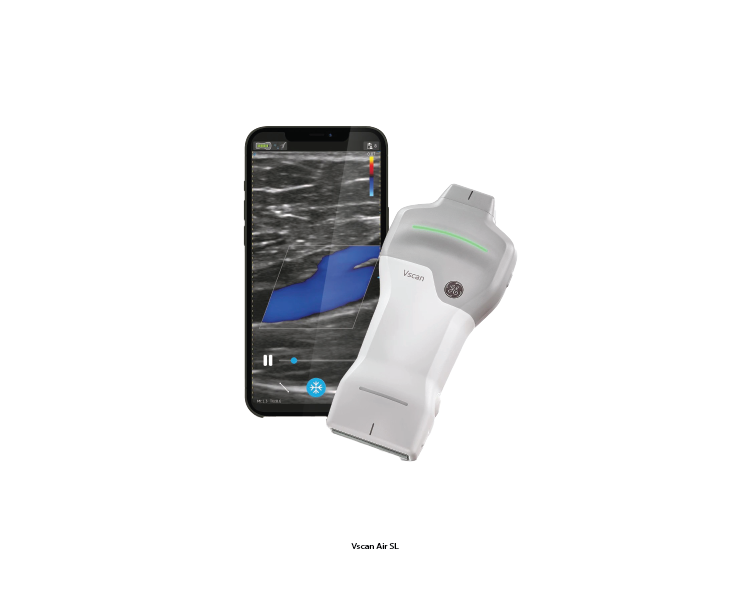Vscan Air SL
The Vscan Air SL is a cutting-edge, pocket-sized ultrasound device developed by GE Healthcare. Designed to provide high-quality imaging on the go, this innovative system brings advanced diagnostic capabilities to a handheld form. The Vscan Air SL leverages wireless technology and a user-friendly interface to offer real-time ultrasound imaging, making it an ideal tool for clinicians who need quick and reliable diagnostic information in a variety of settings, from the clinic to the patient's bedside or remote locations.
Key Features of Vscan Air SL Ultrasound System
1. Portability and Convenience:
• Handheld Design: Compact and lightweight, the Vscan Air SL fits easily into a pocket, allowing clinicians to carry it anywhere.
• Wireless Operation: Completely wireless, enhancing mobility and ease of use in various clinical environments.
2. High-Quality Imaging:
• Dual-Probe Technology: Features a dual-probe with both linear and sector transducers in one device, enabling a wide range of imaging applications.
• Crystal Clear Images: Provides high-resolution images for accurate diagnosis.
3. User-Friendly Interface:
• Intuitive App-Based System: Operated via a user-friendly app on compatible smartphones and tablets, ensuring ease of use and quick learning.
• Touch Screen Controls: Offers touch-based controls for efficient navigation and operation.
4. Durability:
• Rugged Design: Built to withstand the rigors of daily clinical use, including drops and exposure to various environmental conditions.
• Long Battery Life: Ensures extended use throughout the day without frequent recharging.
5. Connectivity and Data Management:
• Cloud Integration: Allows for easy storage and sharing of images and data through cloud-based systems.
• DICOM Compatibility: Supports integration with hospital information systems (HIS) and Picture Archiving and Communication Systems (PACS) for streamlined data management.
Application of Vscan Air SL Ultrasound System
1. Point-of-Care Ultrasound (POCUS):• Emergency Medicine: Ideal for rapid assessment in emergency situations, such as trauma, cardiac arrest, and shock, providing critical information for immediate decision-making.
• Critical Care: Useful in intensive care units (ICUs) for evaluating critically ill patients, including monitoring fluid status and guiding interventions.
2. Cardiology:
• Echocardiography: Enables quick evaluation of cardiac function, aiding in the assessment of heart conditions like heart failure, valvular disease, and pericardial effusion.
• Screening and Follow-Up: Useful for routine cardiac screening and follow-up examinations in outpatient settings.
3. Primary Care:
• Routine Examinations: Assists primary care physicians in performing routine ultrasound examinations, such as abdominal, obstetric, and gynecological assessments.
• Guided Procedures: Provides real-time imaging to guide procedures like injections and biopsies.
4. Musculoskeletal:
• Injury Assessment: Helps in evaluating musculoskeletal injuries, such as sprains, strains, and fractures.
• Guided Interventions: Useful for guiding therapeutic interventions like joint injections and aspirations.
5. Vascular Imaging:
• Peripheral Vascular Assessment: Enables the evaluation of peripheral arteries and veins for conditions like deep vein thrombosis (DVT) and arterial occlusions.
• Carotid Artery Imaging: Assesses the carotid arteries for stenosis or plaque buildup, aiding in the prevention of stroke.
6. Obstetrics and Gynecology:
• Fetal Monitoring: Provides quick assessments of fetal health and development, useful in prenatal care.
• Gynecological Examinations: Assists in evaluating gynecological conditions, such as ovarian cysts and uterine abnormalities.

